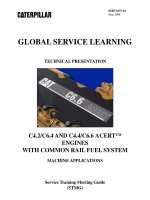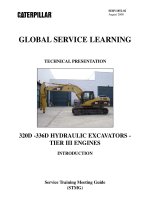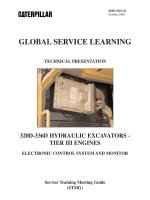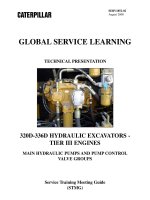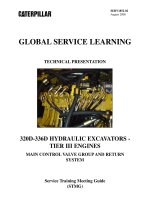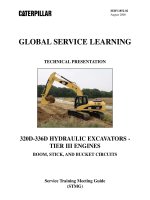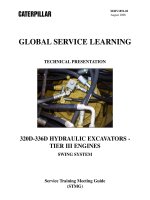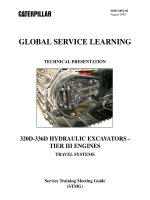Hệ thống thủy lực máy đào CATERPILLAR SERIE D - P11
Bạn đang xem bản rút gọn của tài liệu. Xem và tải ngay bản đầy đủ của tài liệu tại đây (565.03 KB, 38 trang )
SERV1852-02
October 2008
TECHNICAL PRESENTATION
320D-336D HYDRAULIC EXCAVATORS -
TIER III ENGINES
ELECTRONIC CONTROL SYSTEM AND MONITOR
Service Training Meeting Guide
(STMG)
GLOBAL SERVICE LEARNING
320D-336D HYDRAULIC EXCAVATORS -
TIER III ENGINES
ELECTRONIC CONTROL SYSTEM AND MONITOR
AUDIENCE
Level II - Service personnel who understand the principles of machine systems operation,
diagnostic equipment, and procedures for testing and adjusting.
CONTENT
This presentation provides an introduction and describes the components and systems operation
of the 320D-336D electronic control system and monitor. Additional presentations will cover
the machine walkaround, engines, pumps and controls, main control valve group, swing system,
travel system, and tool control systems in more detail. This presentation may be used for self-
paced and self-directed training.
OBJECTIVES
After learning the information in this presentation, the technician will be able to:
1. identify the components and explain the operation of the 320D-336D electronic control
system and monitor, and
2. diagnose problems in the electronic control system.
REFERENCES
320D Hydraulic Excavator Specalog AEHQ5856
324D Hydraulic Excavator Specalog AEHQ5663
325D Hydraulic Excavator Specalog AEHQ5665
328D Hydraulic Excavator Specalog AEHQ5706
330D Hydraulic Excavator Specalog AEHQ5667
Machine Monitoring System - Systems Operation RENR8068
Self-study "300D Series Hydraulic Excavators, 345C Hydraulic Excavator,
and 365C & 385C Large Hydraulic Excavators SERV7032
iTIM " '300C' Series Hydraulic Excavators-Electronic Control Systems" SERV2693
iTIM "325C Hydraulic Excavators-Hydraulic Systems" SERV2701
325D Hydraulic Schematic KENR6157
Estimated Time: 1 hour
Illustrations: 24
Form: SERV1852-02
Date: September 2008
© 2008 Caterpillar
TABLE OF CONTENTS
ELECTRONIC CONTROL SYSTEM.........................................................................................5
Engine Speed Control...........................................................................................................12
Automatic Engine Speed Control (AEC) .............................................................................13
One Touch Low Idle.............................................................................................................15
Engine Speed Protection.......................................................................................................16
Visconic Demand Fan Cooling System................................................................................20
Hydraulic Demand Fan Cooling System..............................................................................22
Travel Speed Control............................................................................................................24
Pump Regulation...................................................................................................................26
Swing Brake Operation.........................................................................................................28
Heavy Lift Mode...................................................................................................................30
Back-up System....................................................................................................................31
MONITOR..................................................................................................................................34
CONCLUSION...........................................................................................................................38
SERV1852-02 - 3 - Text Reference
10/01 Electronic Control System
PREREQUISITES
"Fundamentals of Mobile Hydraulics Self Study Course" TEMV3002
"Fundamentals of Power Train Self Study Course" TEMV3003
"Fundamentals of Electrical Systems Self Study Course" TEMV3004
"Fundamentals of Engines Self Study Course" TEMV3001
NOTES
Nomenclature Change: During the fourth quarter of 2008, the 325D and 330D
nomenclature changed. The 325D became the 329D and the 330D became the 336D for
most arrangements.
The exceptions are as follows:
- The nomenclature for the 325D MH and 330D MH did not change.
- The nomenclature for the 325D FM and 330D FM did not change.
- The 325D HD HW did not change into 329D HD HW. This model is being discontinued.
However, the 330D HD HW changed to the 336D HD HW.
SERV1852-02 - 4 - Text Reference
10/01 Electronic Control System
1
ELECTRONIC CONTROL SYSTEM
The Electronic Control System controls many of the functions of the 320D-336D Excavators
and is pretty much the same system for the 311D to the 345D.
The electronic control system uses two data links to communicate:
- The Engine ECM, the Machine ECM, the monitor, Cat ET, the optional Product Link
ECM (PL321SR) , and the Gateway WorldViewer ECM (PL300) communicate via the
Cat Data Link.
- The soft switch panel communicates with the Machine ECM and the monitor on the
J1939 CAN Data Link. The switch panel is not connected to the Cat Data Link.
For the Machine Security System, the software is part of the Machine ECM. A MSS keyreader
provides input into the Machine ECM through the Can Data Link.
Cat ET is used to diagnose system problems via the Cat Data Link. Some of the input and
output components of the Machine ECM are also shown in this illustration.
SERV1852-02 - 5 - Text Reference
10/01 Electronic Control System
Swing Brake Release Solenoid
Travel Speed Change Solenoid
Power Shift Pressure Solenoid
Back-up Switch
Implement Pressure Switch
Key Start Switch
Engine Speed Dial
Pump Pressure Sensor 1
Engine Speed Sensor
320D Only
Switch
Panel
ECM
One Touch Low Idle Switch
Left Travel Pressure Switch
Pump Pressure Sensor 2
Machine
ECM
Monitor
Quick Coupler Switch
Overload Warning Switch
Air Cleaner Switch
Hydraulic Oil Filter Switch
Fuel Filter Switch 2
Fuel Filter Switch 1
Fine Swing Switch
Water Separator Level Sensor
Attach Hydraulic Oil Filter Switch
Travel Alarm
Relay
Engine Oil Pressure Switch
Hydraulic Oil Level Switch
Fuel Level Sensor
Hydraulic Oil Temp Sensor
Engine Oil Level Switch
Alarm
Engine Coolant Level Switch
Alternator
Engine Coolant Temp Sensor
Hydraulic Lock Switch
Hydraulic Lock Solenoid
CAT Data Link
320D - 336D MACHINE ECM
INPUTS AND OUTPUTS
Engine ECM
J1 J2
OK
Gateway
Worldview
ECM
PL300
Right Travel Pressure Switch
Back-up
Switch
Communication
Adapter Il
Service
Connect or
Elect ronic
Technician
Heavy Lift Mode
Switch
Two-speed
Travel Switch
Travel Alarm
Cancel Switch
Work Lights
Switch
Upper Window
Wiper Switch
Upper Window
Washer Switch
Work Tool
Control Switch
Automatic Engine Control
(AEC) Switch
AIH Control Status (Start Aid)
SmartBoom Switch
CAN Data Link
Product Link
ECM
PL121SR
MSS
Key Reader
NOTE: The Gateway WorldViewer ECM or PL300 Network Adapter is the hardware
that enables Health Watch on Caterpillar Machines equipped with Caterpillar
Electronic Control Modules (ECMs). In addition, the 4 switch channels can be used on
any machine, Cat or non-Cat, to monitor on board switches. It should also be noted
that PL121 must be installed and used in combination with PL300 to enable Heath
Watch subscriptions.
PL321 is a combination of the PL300 Network Adapter and the PL121SR Radio.
For some markets, factory installed standardization goes into effect for Product Link.
PL321 will be listed as a "required optional attachment."
Health Watch provides:
- Event and Diagnostic Codes, History and Alerts
- Event and Diagnostic Code Troubleshooting Procedures
- Fuel Level, History and Alerts
- Fuel Used, History & Graphic Display
- Refueling History
- 4 Digital Switch Channels
SERV1852-02 - 6 - Text Reference
10/01 Electronic Control System
The Machine ECM (1) is located on the left side of the machine in the compartment behind the
cab.
The inputs and outputs of the Machine ECM connect to the machine harness by two 54 pin
connectors (2).
2
SERV1852-02 - 7 - Text Reference
10/01 Electronic Control System
2
1
The Engine ECM (1) is mounted to the engine (2).
Accessibility to the Engine ECM with the engine in-chassis is limited.
3
SERV1852-02 - 8 - Text Reference
10/01 Electronic Control System
1
2
The Switch Panel ECM is part of the right console. The Switch Panel ECM is non-flashable
through Cat ET.
The Switch Panel ECM (1) receives inputs from rocker type switches (2) and from soft
switches (3) in soft switch panel (4).
4
SERV1852-02 - 9 - Text Reference
10/01 Electronic Control System
1
2
3
4
The soft switch panel includes switches that either turn a function ON/OFF or allow the
operator to toggle through different modes of the selected function. The soft switches provide
the operator with the following functions:
Two-speed travel switch (1): When the button is pushed the travel speed is toggled between
low and auto.
- The rabbit indicator indicates auto speed.
- The tortoise indicator indicates low speed.
Automatic Engine Control (AEC) switch (2): The AEC function automatically reduces
engine speed while there is no hydraulic demand, which reduces noise and fuel consumption.
- The AEC switch disables and enables the AEC function.
- Initially, AEC reduces the engine speed by 100 rpm after there has been no hydraulic
demand for approximately three seconds.
- Then AEC reduces the engine rpm to approximately 1300 rpm after there has been no
hydraulic demand for an additional three seconds.
- The additional three second AEC delay time and the low speed of 1300 rpm can be
changed using the monitor or Caterpillar Electronic Technician (Cat ET).
5
SERV1852-02 - 10 - Text Reference
10/01 Electronic Control System
1 2 3
4
8
7
6
5
Travel alarm cancel switch (3): The travel alarm cancel switch is a momentary two-position
switch.
- The travel alarm sounds when travel is detected.
- The travel alarm stops immediately if the travel alarm cancel switch is depressed.
- The travel alarm switch is reset every time the travel pressure switch opens.
Work tool switch (4): The work tool switch will show the selected work tool on the monitor
display. Press the switch repeatedly to change the selected work tool. When the desired work
tool is highlighted in the monitor display press the "OK" button on the monitor to select the
work tool shown.
Work lights switch (5): The work lights switch toggles between the different work light
combinations. Two different work light patterns are available.
- Pattern 1: Chassis work lights and cab work lights
- Pattern 2: Chassis work lights, cab work lights, and boom work lights
Upper window wipers switch(6): The wiper switch toggles between the following different
modes of the wipers.
- six second delay
- three second delay
- continuous operation
- off
Upper window washer switch(7): The windshield washer fluid switch is an ON/OFF switch.
Heavy lift mode switch (8): The Heavy lift mode switch can be selected to increase lifting
capability and provide improved controlability of heavy loads.
- When heavy lift is turned on, the main relief valve maximum pressure increases from
35,000 MPa (5080 psi) to 36,000 MPa (5225 psi), making it possible to operate at the
system at a higher pressure.
- In Heavy Lift Mode, the maximum engine speed is limited to engine speed dial 6
(1510 ± 90 rpm).
- Hydraulic horsepower maximum output is reduced to 60%.
SERV1852-02 - 11 - Text Reference
10/01 Electronic Control System
6
Engine Speed Control
The Machine ECM converts the signal from the engine speed dial into a pulse width
modulated (PWM) signal. The information is then sent to the Engine ECM over the Cat Data
Link.
The engine speed dial is divided into 10 positions. The dial position is displayed on the
character display of the monitor panel.
SERV1852-02 - 12 - Text Reference
10/01 Electronic Control System
Engine Speed
Dial
CAN Data Link
Engine ECM
CAT Data Link
Machine ECM
Monitoring
System
J1
J2
OK
ENGINE SPEED CONTROL
7
Automatic Engine Speed Control (AEC)
The Automatic Engine Speed Control (AEC) automatically reduces engine speed when the
machine is inactive or under low load. The AEC system is designed to reduce fuel
consumption and noise. Lower engine speeds can also increase engine life.
The engine speed dial, the AEC switch, the implement pressure switch, the left travel pressure
switch, the left right pressure switch, and the straight travel pressure switch send input signals
to the Machine ECM. The Machine ECM processes the input signals and sends corresponding
output signals to the Engine ECM to control the engine speed.
The AEC system will be inoperable while the backup switch of the electronic controller system
is in the MAN position.
The engine rpm will recover automatically to the setting of the engine speed dial when any
hydraulic function is activated. The AEC system operates in three modes
SERV1852-02 - 13 - Text Reference
10/01 Electronic Control System
Engine Speed
Dial
CAN Data Link
Engine ECM
CAT Data Link
Machine ECM
Soft Switch
Panel
J1 J2
AEC Switch
Implement Pressure Switch
Left Travel Pressure Switch
AUTOMATIC ENGINE
CONTROL (AEC)
Right Travel Pressure Switch
Straight Travel Pressure Switch
The AEC is set by the AEC switch. The switch indicator will illuminate during the second
setting of the AEC. The second setting of the AEC is available immediately after the engine
start switch is turned to the ON position. The AEC can be set in the first stage and the second
stage by alternately pressing the switch.
- The First Stage Mode of the AEC will lower the speed setting of the engine speed dial by
approximately 100 rpm in the "no load" condition. The speed setting dial must be
between 5 and 10. The position of the AEC switch is OFF.
- The Second Stage Mode of the AEC will reduce the engine speed to approximately 1300
rpm in the "no load" condition. The speed setting dial must be between 5 and 10. The
position of the AEC switch is ON.
- The Manual Low Idle Mode is also called one touch low idle and is explained in more
detail on the next page. The speed setting dial must be between 3 and 10, while the
position of the AEC switch can be either ON or OFF.
NOTE: When the main back-up switch is turned to the ON position (Manual), the AEC
function is disabled.
SERV1852-02 - 14 - Text Reference
10/01 Electronic Control System
8
One Touch Low Idle
When the one touch low idle switch is pressed and the machine is not under a load, the engine
speed can be lowered by more than the speed setting of the AEC Second Stage Mode. When
normal operations have resumed, the engine speed for the dial setting will return to the
corresponding rpm.
The one touch low idle feature will activate during all "stopped" conditions of the implement,
swing, travel, and tools.
The following components are in the OFF position: the implement pressure switch, the left
travel pressure switch, the right travel pressure switch, the straight travel pressure switch, and
the attachment pedal pressure switch. However, when the one touch low idle switch is pressed,
the Machine ECM will signal the Engine ECM to lower the engine speed to engine speed dial
setting 2 setting, which is approximately 1020 rpm.
The one touch low idle overrides the AEC.
SERV1852-02 - 15 - Text Reference
10/01 Electronic Control System
CAN Data Link
Engine
ECM
CAT Data Link
Machine
ECM
J1 J2
Implement Pressure
Switch
Low Idle
Switch
Right Joystick
ONE TOUCH
LOW IDLE
Straight Travel
Pressure Switch
Left Travel
Pressure Switch
Right Travel
Pressure Switch
Attachment Pressure
Switch
